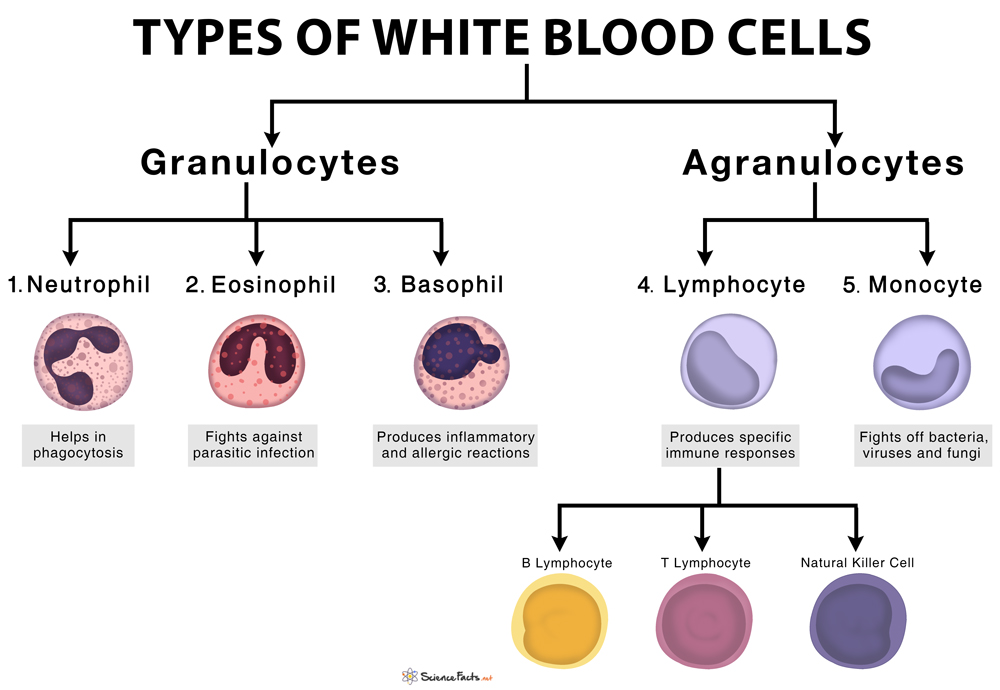All WBCs are nucleated cells that distinguish them from non-nucleated red blood cells (RBCs) and platelets. Normal WBC count is usually between 4 × 109/L and 1.1 × 1010/L, which constitute approximately 1% of the total blood volume, thus about 45% less numerous compared to RBCs.
Types of White Blood Cells
1) Neutrophil
2) Eosinophil
3) Basophil
4) Lymphocyte
5) Monocyte
Granulocyte: WBCs with granules in their cytoplasm. Granulocytes are of three types: 1) neutrophil, 2) eosinophil, and 3) basophil. Agranulocytes: WBCs with no distinct granules in their cytoplasm. Agranulocytes are of two types: 4) monocyte and 5) lymphocyte. Abundance: Constitutes 62% of the total leukocyte count. Composition: The cytoplasm of a neutrophil looks transparent because of the presence of fine granules. Other organelles like the Golgi apparatus, mitochondria, and ribosomes are also present. Lifespan: It can vary widely between 5 to 135 hours. Functions
Engulfing pathogens like bacteria by a process called phagocytosis Consuming and digesting pathogens by releasing superoxide radicals to present them in the form of pus
Abundance: Comprises about 2-4% of the total WBCs. Their number is found to increase in response to a parasitic infection. Composition: Acidic granules in the cytoplasm, which contains enzymes and proteins that take up pink-orange color when stained with eosin. Lifespan: Tissue life of about 2 to 6 days. Functions
Destroying large parasites such as hookworms and tapeworms, by secreting specific chemicals Found to cause allergic reactions such as asthma, hay fever, and infections of hives
Abundance: Accounts for only 0.5% of the total white blood cell count. Composition: Sharing similar physicochemical properties with other white blood cells. Lifespan: About 60–70 hours Functions
Producing inflammatory reactions during an immune response by releasing immune-complexes like histamine, serotonin, and heparin Producing the body’s response to allergic reactions during anaphylaxis, asthma, and hay fever
a) B cells: Also called B Lymphocytes, it is identified by the presence of B cell receptor or BCR b) T cells: Also called T Lymphocytes, it identified by the presence of T cell receptor or TCR c) Natural killer cells (NK cells): Identified by the presence of CD3 receptor Abundance: Comprising 30% of the total white blood cells. They are much more abundant in the lymph nodes of the lymphatic system compared to blood. Lifespan: Mostly have a short life span ranging from a week to a few months, but a few even live for years, thus providing immunity to certain infections. Functions
Providing body defense against infections by recognizing antigens, producing antibodies, and killing infected cells B cells produce antibodies that bind and attack pathogens and helps in their destruction T cells provide immunity from foreign pathogens through an antibody-mediated response called adaptive immunity NK cells provide the first line of defense in our body called innate immunity that helps to destroy virus-infected cells and other harmful organisms. They also play a role in destroying cancer cells
Abundance: Consists of about 2 to 10% of the total circulating white blood cells, that may increase in case of infections. Composition: Contains numerous fine granules that are most abundant near the cell membrane. Lifespan: About 24 hours. Functions
Having a similar role to neutrophils that work by phagocytosis. Helping in the production of antibodies Producing cytokine, a specific group of small chemicals that help to kill pathogens. Helping in antigen presentation using specific receptors.
